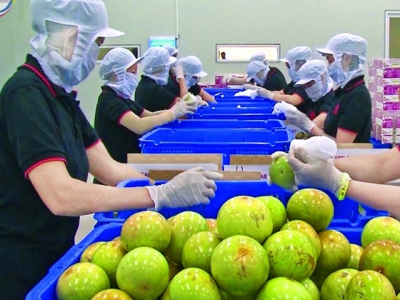Restructuring of agriculture sector yields breakthroughs

Six years after launching the project restructuring the agricultural sector to enhance added value and sustainable development, Vietnam’s agriculture sector has shown many signs of improvement. However, limitations remain, especially in the development of value chains associated with consumption and market development.
Seafood, a highlight of restructuring
The Prime Minister approved the restructuring project on June 10, 2013. Since then, large-scale intensive production regions have been formed for shrimp, Tra fish, rice and fruits. These have been linked to processing technologies and consumption. The export revenues of agricultural, forestry and fishery products in the 2013-2018 period sharply increased to reach US$197.51 billion, at an average rate of US$32.9 billion per year. The export figure in 2018 hit a record level at US$40.02 billion and is estimated at about US$41-42 billion this year.
Seafood has been a highlight of the restructuring process with surging export turnover. Tran Dinh Luan, Director General of the Directorate of Fisheries, said that to implement restructuring, the fishery sector had to reorganize production, establish new cooperatives with various linkage models that have yielded high economic values. For example, Tra fish products are increasingly diversified with more than 80 kinds and each Tra fish now weighs from 3-4 kg instead of only 0.8kg as before. The sector has observed regulations and recommendations of state agencies to drive production according to market demand, which has gradually turned seafood into a key sector.
In rice farming, this year’s star is the ST25 rice variety of Labor Hero Ho Quang Cua, recognized as the “World’s Best Rice 2019” last month, boosting the prestige of Vietnamese rice. Nguyen Quoc Manh, Head of the Division of Industrial Plants of the Department of Crop Production under the Ministry of Agriculture and Rural Development (MARD), said the MARD has recently directed localities to shift from low efficiency rice farming to cultivation of other plants, and expand farming areas of good quality rice to meet export demand. So far, these farming areas have increased by 10-15 percent compared to 2018. Vietnam’s rice export prices are almost equal to and sometimes even higher than those of Thailand.
Many enterprises have recently invested in the processing industry. In 2019, 17 large-scale agricultural processing projects applying modern technologies have been inaugurated with total investment of about VND20 trillion.
Weakness in linkage chains
However, the director of the Institute of Policy and Strategy for Agriculture and Rural Development under the MARD, Tran Cong Thang, said although the state has implemented specific policies in agriculture like building a large-scale rice field model, and regrouping lands, many enterprises still encounter difficulties in meeting requirements, especially in intensive processing.
According to Thang, the policies have not been consistent and practical, particularly in terms of bank credit, making it difficult for farmers to join in the linkage chain.
To solve the problem, Thang recommended setting up logistics systems near material zones or specialized agricultural production areas to encourage investment in production and trade. That, in turn, would make bank loans more accessible to local farmers.
Currently, there are only linkage chains in production and consumption, not in cash flow. The participation of banks is therefore necessary to reduce risks in the cash flow linkage chain.
With the support of local authorities, associations and participation of different sectors like agriculture promotion, forestry promotion, businesses and banks, the linkage chains are expected to experience rapid development. Tran Dinh Luan urged changes in the policy on dissemination of information in both the short and long run to help farmers change their thinking and find the right way to meet market requirements.
Related news
 Vietnam’s rice sector forecast to face difficulties in 2020
Vietnam’s rice sector forecast to face difficulties in 2020 The Philippines and China, Vietnam’s two major rice export markets, may reduce rice imports in 2020.
 Vietnam sees rice export growth in January
Vietnam sees rice export growth in January Vietnam exported 560,000 tonnes of rice in January 2020, earning 270.3 million USD, an increase of 12 percent in volume and 39 percent in value month-on-month
 Forum seeks ideas for lifting farm produce trade barriers
Forum seeks ideas for lifting farm produce trade barriers Foods of Vietnam will implement communication campaigns to promote Vietnam’s food industry and its sub-sectors through media channels and trade promotion events